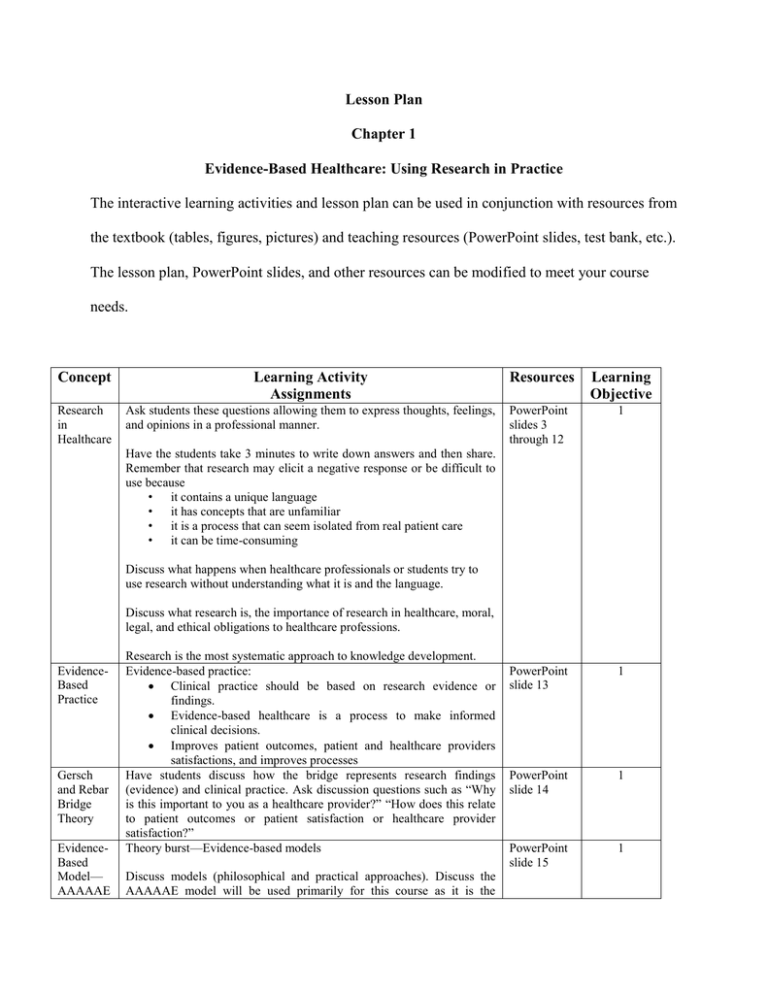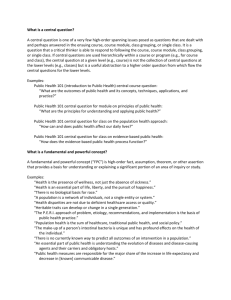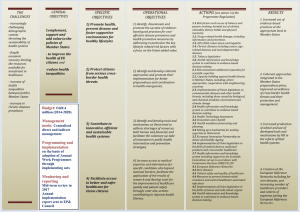Lesson Plan
advertisement

Lesson Plan Chapter 1 Evidence-Based Healthcare: Using Research in Practice The interactive learning activities and lesson plan can be used in conjunction with resources from the textbook (tables, figures, pictures) and teaching resources (PowerPoint slides, test bank, etc.). The lesson plan, PowerPoint slides, and other resources can be modified to meet your course needs. Concept Learning Activity Assignments Resources Learning Objective Research in Healthcare Ask students these questions allowing them to express thoughts, feelings, and opinions in a professional manner. PowerPoint slides 3 through 12 1 PowerPoint slide 13 1 PowerPoint slide 14 1 PowerPoint slide 15 1 Have the students take 3 minutes to write down answers and then share. Remember that research may elicit a negative response or be difficult to use because • it contains a unique language • it has concepts that are unfamiliar • it is a process that can seem isolated from real patient care • it can be time-consuming Discuss what happens when healthcare professionals or students try to use research without understanding what it is and the language. Discuss what research is, the importance of research in healthcare, moral, legal, and ethical obligations to healthcare professions. EvidenceBased Practice Gersch and Rebar Bridge Theory EvidenceBased Model— AAAAAE Research is the most systematic approach to knowledge development. Evidence-based practice: Clinical practice should be based on research evidence or findings. Evidence-based healthcare is a process to make informed clinical decisions. Improves patient outcomes, patient and healthcare providers satisfactions, and improves processes Have students discuss how the bridge represents research findings (evidence) and clinical practice. Ask discussion questions such as “Why is this important to you as a healthcare provider?” “How does this relate to patient outcomes or patient satisfaction or healthcare provider satisfaction?” Theory burst—Evidence-based models Discuss models (philosophical and practical approaches). Discuss the AAAAAE model will be used primarily for this course as it is the simplest to use and put into practice: Discuss each element of the model—overview: Assess: Assess the situation. Identify an issue, concern, or question in clinical practice. Ask: Ask a question. Use a questioning format, such as PICO, to ask a question relevant to a clinical situation. Acquire: Find research applicable to the situation/question. Find credible and current resources to find evidence from scientific research studies. Appraise: Validate the research findings. Analyze, critique, and evaluate the research study for validity (truthfulness) and applicability. Apply: Application of the EBI. Integrate clinical expertise, patient perspectives, and scientific knowledge (EBI) into a plan of action in the provision of care. When to Find Evidence Evaluate: The last step in the process in evaluation. Evaluation or measuring patient outcomes as a result of your action is important in adding knowledge to the profession, providing support for policy changes, and incorporating EBI into clinical practice (EBP). Give examples of clinical situations and ask students what actions they should take: Find research Follow policy or procedure or standard of care or care guidelines Ask a peer or supervisor Use clinical experience or intuition Read a textbook or reference Clinical Questions Summarize at the end … Note what actions they did the most often and what actions the least often. Theory burst—discuss clinical questions. What clinical questions are, what they entail, the different types: Who, What, When, and Where method PICO or PICOT method Provide students with two or three questions and have them critique them using the Who, What, When, and Where method or the PICO/PICOT method. Examples: Do you know whether to use humor when working with an anxious patient? Do you know what to assess (pain, fatigue, number of sticks, vein condition) in order to decide whether to establish a venous port for blood draws in a patient who needs blood drawn PowerPoint slide 16 1 PowerPoint slides 17 through 20 1 Where to Find Evidence How to Find Evidence Research Report repeatedly and regularly? Do you know how young children perceive the X-ray machine? Divide students in small groups and have them come up with a clinical concern/question. Have the students develop a clinical question from the concern using the Who, What, Where, and When method and then the PICOT method. Discuss the differences and the similarities. They both can be used for EBP to address a clinical concern. Give students a clinical question and have them conduct a 10-minute search using a laptop, smartphone, tablet, etc. At the end of 5 minutes, ask them Where did you go? How did you get there? Why did you go there? What did you find there? What is the strength of the evidence you found? Where should you go to find evidence? Why? Have a research librarian come to class and discuss how to conduct research at your school/through your library. Theory burst—describe a research report (components of a primary research report). PowerPoint slide 21 1 PowerPoint slide 22 1 PowerPoint slides 23 through 27 Compare and contrast primary research reports with other types of articles—commentary, information, summaries, etc. Provide students with examples of several types of “articles” from newspaper, magazines, google website, professional journal, and a primary research article. Have the students label them. Go through and discuss the labels and compare and contrast the nonresearch article with the primary research report. What Is Evidence? Review where research reports are found by having students identifying where they would to look for research reports. Discuss what evidence is and isn’t: Evidence is findings from research studies that have followed the research process. Discuss different levels of strength of sources See Table 1.1 PowerPoint slides 28 through 31 Evidence is not intuition, information from informal sources, etc. Abstract Discuss how the student will need to evaluate the research for appropriateness in applying to practice. Discuss the abstract—components, purpose, where found. Divide students into small groups and give each group an abstract that might address one of the clinical questions mentioned earlier in the lesson plan. Have them determine if they would like to read the full article/if the abstract is relevant to the clinical question. Have them verbalize rationale for their response. Chapter 1 PowerPoint slide 32 1 Evidence-Based Healthcare: Using Research in Practice LEARNING OUTCOME The student will relate research to the development of the professional healthcare practice. CHAPTER OVERVIEW Chapter 1 discusses the relevance of research to healthcare practice. The chapter identifies the five questions that healthcare providers might have about a research report and how these are used to organize the chapters of the book. The five questions are: 1. What is the answer to my practice question—what did the study conclude? 2. Why did the author(s) reach these conclusions—what did they actually find? 3. To what types of patients do these research conclusions apply—who was in the study? 4. How were these people studied—why was the study performed that way? 5. Why ask that question—what do we already know? The organization of the text, starting with the conclusions of a research report and moving forward to the introduction of a research report, is described. KEY POINTS FROM CHAPTER 1 1. Understanding research is essential to answering clinical questions and to providing highquality care. 2. Evidence-based practice helps professional healthcare providers utilize research to make informed decisions regarding patient care. 3. A gap exists between available research (evidence-based information) and the need for active application of this research (EBI) to enact positive growth and/or change within the individual’s professional environment. 4. Evidence-based models offer a philosophical and practical approach in applying valid research findings to clinical practice in any healthcare field. One model use six steps—Ask, Assess, Acquire, Appraise, Apply, and Evaluate—to assist in the application of available research to clinical practice. 5. Reading research is not the only way to find answers to clinical questions; other ways include use of experts or authorities, past experience, and intuition. 6. Effective clinical questions for evidence-based practice include a concern that someone else has studied, a concern that can be measured or described, and a concern that is relevant to healthcare. The question also addresses Who, Where, What, and When in terms of the clinical concern—CORE CONCEPT. 7. Finding research occurs when something occurs out of the ordinary in your clinical practice, outcomes of care differ in one or more patients without clear reasons and/or you need to develop a policy, procedure, or standards for care—CORE CONCEPT. 8. Evidence-based practice is the process of conscious and intentional use of research and theorybased information to answer questions and make clinical decisions. Reading and using research is part of evidence-based practice. 9. Healthcare research is the systematic gathering of information to gain, expand, or validate knowledge about health and responses to health problems. Evidence-based practice uses research-based evidence to plan and implement quality care—CORE CONCEPT. 10. Reports of research can be found through: a. Printed indexes b. The Internet—relevant World Wide Web sites for healthcare are listed in Table 1.1 c. Electronic databases 1) Commonly used electronic databases are CINAHL, MEDLINE, and PubMed. 2) Key words are used to search electronic databases. Key words are descriptive terms regarding a research question. 11. Abstracts of research can be very helpful in narrowing down or focusing on the appropriate research to acquire and read. Abstracts cannot and should not be depended on to provide a level of understanding of the research that would support clinical decision making—CORE CONCEPT. 12. Abstracts are useful for identifying whether a study is relevant to a particular clinical question and whether the study sample is similar enough in order to be useful to the clinical sample of interest to the nurse. 13. Systematic reviews are a written compilation of research relevant to a research question. The COCHRANE database is a source for systematic reviews. The Joanna Briggs Collaboration promotes evidence-based health care through reviews of research and the development of Best Practice Evidence-Based sheets. TEACHING/LEARNING STRATEGIES IN-CLASS PRACTICE RESEARCH STUDY Included in Appendix C is an in-class survey that students could take during the first class meeting. Some of the information on the survey is exactly the type of information used to develop the “Fictional Article” (Appendix B) used as an example throughout the text. There is some additional information asked that may be used for different in-class activities. You can easily enter the data into any database or statistical package. If you choose to use the survey and enter the data, it could be used as an example throughout the class. However, even hand tabulation of the data would not be difficult for small classes. IN-CLASS ACTIVITIES OR CHAT ROOM DISCUSSION QUESTIONS 1. Discussion Questions: Begin class with a discussion of the last research study that students have read: a. Why did you read it? b. What did you find/What do you remember from it? c. What parts did you read? 2. Critical Thinking Exercises: Ask students to identify a clinical question they have wondered about. If they do not have one, pose the question: Would physical therapy sessions be better scheduled in the evenings in order to prepare patients for a restful sleep? a. Discuss how they might go about getting the answer to the question. b. Discuss the relative strengths and drawbacks to each of the four approaches to answering clinical questions that are described in the chapter: research, authority, experience, and intuition. c. How would they summarize and present their findings to other healthcare team members? ONLINE ACTIVITIES 1. Critical Thinking Exercises: a. Present a clinical question and ask students to provide an answer and identify their source for that answer. Possible questions include: 1) What information is most important to a newly diagnosed patient with diabetes: etiology, prognosis, treatment, or self-care requirements? 2) What are the optimal intervals for tube feedings to maximize absorption and use of nutritional supplements? b. Tally whether answers were found using research, authority, past experience, or intuition. 2. Written Assignment: a. Ask students to perform a database search for a research citation about a clinical question, such as the effects of chocolate on depression. Have them submit their search results from one established electronic database, such as CINAHL. b. Note: A search of CINAHL in April 2013 yielded three specific citations for chocolate and depression: 1) Carrieri, M. P., Cohen, J., Winnock, M., & Salmon, D. (2010). Chocolate intake, depression, and clinical progression in HIV-HCV coinfected patients: Still more questions than answers. Archives of Internal Medicine, 170(17), 1607. 2) Bohon, C., & Stice, E. (2011). Reward abnormalities among women with full and subthreshold bulimia nervosa: A functional magnetic resonance imaging study. International Journal of Eating Disorders, 44(7), 585–595. 3) Rose, N., Koperski, S., & Golomb, B. (2010). Mood food: Chocolate and depressive symptoms in a cross-sectional analysis. Archives of Internal Medicine, 170(8), 699–703.






